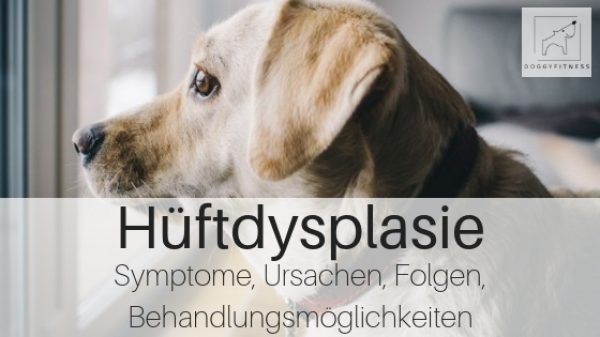Hip dysplasia in dogs
Hip dysplasia (HD for short) is a mostly congenital maldevelopment of the hip joint. In this case, the femoral head and acetabulum do not fit together. As a rule, it occurs bilaterally. One side, however, is increasingly affected.
What happens in the hip joint?
To help you understand what happens in the hip joint, let’s take a quick trip into anatomy. A joint consists of a condyle and a socket. In a healthy hip joint, the femoral head centers in the socket. They form a stable joint. In a dog with HD, the femoral head is not adequately fixed in the socket. The joint is unstable.
Consequences of HD
Damage is caused by the incorrect loading and instability of the joint. The joint capsule, muscles, tendons and ligaments are severely strained and stretched. Osteoarthritis develops on the smooth joint surfaces. As a result, pain occurs. In addition, the spine can be damaged by the incorrect load.
How does hip dysplasia develop? Which dogs are affected?
In most cases, it is genetic. In principle, all dogs can be affected. It occurs especially in German Shepherds, Rottweilers and Appenzeller Mountain Dogs. Labrador or Golden Retrievers are also often affected. Likewise, a poorly cared for fracture or improper nutrition can promote HD. Also a misuse and overload in growth can be a reason. Furthermore, age-related wear and tear of the joint can also trigger HD.
What are the symptoms?
The first signs usually appear at a young age. Absence of signs does not mean that the dog is “HD free”. Common signs include “rabbit hobbling” with the hind legs as well as a pronounced hip sway. A wobbly, rocking gait is also possible. Many dogs are sensitive to touch, show lameness and slouching. They have difficulty standing up and avoiding jumps. The muscles of the hind legs are also usually very weak. The dogs are sensitive to the weather.
What are the treatment options?
There are several surgical techniques. These include femoral head resection and pelvic osteotomy. But so is PIN surgery, capsular retraction, and the insertion of an artificial hip joint, to name a few. All procedures are more or less invasive to your dog.
What you can do to avoid surgery
Specific exercises can be used to train the muscles of the hip. It is necessary to stabilize the hip joint. In doing so, you relieve his pain and stop the progression of arthritis. Your dog’s gait and mobility will also improve. In consultation with the veterinarian, a supportive administration of analgesic and anti-inflammatory medication can help (in the short term). A very good and long-term support against pain also offers gold acupuncture. In addition, dietary supplements help.
Precautionary Tip:
If you have a young dog that is to be active in dog sports, it is recommended to do the so-called pre-x-ray. The same applies to service and working dogs. This should happen at a young age (with half a year). This should be done regardless of whether you want to breed with your dog.
You want to support your dog with HD? Then I’ll show you two effective exercises to do in my next article. With it you train the musculature, the coordination and the mobility of your dog.
Dieser Beitrag ist auch verfügbar auf:
Français (French)
Deutsch (German)
Español (Spanish)
















